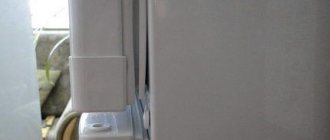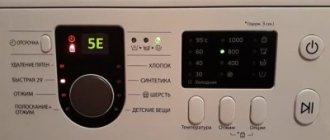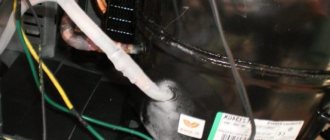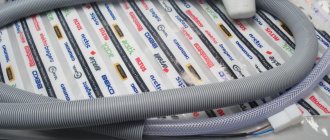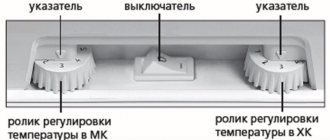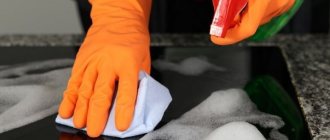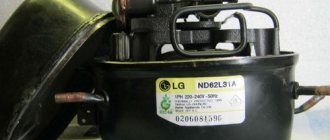The refrigerator is an important kitchen appliance that maintains the freshness and quality of food. If your unit is collecting water under the bottom trays or on the floor, you can assume that the drainage in the refrigerator is not working.
A minor nuisance can become a factor in serious damage and failure of the engine. To eliminate the cause of the leak, clean the drainage installation.
Interior of moisture removal system
How it works
Modern installations require rare defrosting - 1-2 times a year. Nofrost technology allows you to defrost the unit once every two years. This operation is possible thanks to the drainage-evaporation system.
The condensation scheme of the freezer is a model where drops of water are collected by settling moisture on the back wall and flowing to the drainage tube.
The operating principle of the condensate removal system is as follows:
- When the compressor is active, the refrigeration chamber is cooled;
- The temperature in the food storage chamber decreases, the resulting steam condenses on the rear panel;
- Condensation flows down the wall and collects in a gutter;
- Through the tube in the refrigerator, moisture is discharged into the tray;
- The condensate gradually drops into the engine, which ensures the operation of the compressor;
- The compressor operating temperature is above room temperature, moisture evaporates into the external environment and does not require special collection.
Reservoir for collecting moisture
If the equipment is working properly, then the operation of the installation does not require intervention. In case of clogging and malfunction, leaks occur and the risk of engine failure occurs.
Important! The accumulation of liquid under the installation should not be ignored; this is a symptom of a serious breakdown.
How to clean the drainage hole if the blockage occurs at the outlet of the chamber. The liquid does not flow down the tube, but accumulates at the drain level. Ice forms on the back wall of the chamber, which increases the load on the compressor and shortens its service life. The temperature in the freezer may rise, which will lead to food spoilage and the possibility of poisoning.
nofrost technology is based on the same principles as installations with a drip collection system. Except that the drainage and evaporation system is located behind the rear wall, its parts are hidden from the consumer. To gain access to installation and maintenance, the rear panel of the device must be removed.
Where is the drainage tube located and why is it needed?
When examining the bottom of the back wall of the refrigerator, you can identify a small groove with a hole. This is the entrance to the drainage pipe. Normally, condensation that forms on the back wall flows into this hole. In refrigerators equipped with the No Frost system, it is located behind the back wall. This localization prevents the formation of ice and the accumulation of water inside the chamber.
The drainage tube in Indesit refrigerators and other devices is often located on the rear wall of the case. This plastic tube in the device drains excess moisture into a drain pan located on the compressor. When the device is turned on, the drain pan is heated by cooling the compressor in contact with it. This causes the liquid to evaporate. This tube should be cleaned regularly so that condensate can be drained out of the chamber without obstruction.
How to know when it's time to clean
There are many signs that indicate a clogged drain tube. These include:
- accumulation of liquid on the bottom of the chamber;
- unpleasant odor;
- ice formation on the back wall;
- decrease in temperature in the chamber.
All these phenomena indicate that the tube is clogged with small food waste and waste products of bacteria, which rapidly multiply in a humid environment.
What happens if you don't clean it?
If the drainage tube is not cleaned regularly or not at all, the drainage system may become severely clogged. Once formed, the plug will be extremely difficult to remove, so professional help may be required.
Lack of proper care for the drainage system of the refrigerator leads to an increase in humidity inside the chambers and creates conditions for the proliferation of fungi and bacteria.
This can cause premature spoilage of food and the appearance of an extremely unpleasant odor.
View » How to defrost a freezer
What causes drainage to become clogged?
- Several reasons can cause a freezer to break down or become less efficient. The main problem is that food particles get into the drain on the back wall and the tube becomes clogged from the inside. This situation can occur when a liquid spills, crumbs get in, or the integrity of the packaging is compromised. At the entrance to the hole in the tube, deposits of salts and particles of products accumulate, which cannot increase in size due to contact with water and block the outlet hole.
- Another common mistake is overloading the storage room. Because of this, the products are placed close to each other and to the back wall. When the compressor is operating, particles of food and packaging can freeze to the rear wall, and during defrosting, flow into the drain hole into the tank and clog the hole.
- Incorrect installation of the unit. If the refrigerator is skewed in any plane, excess moisture collection is observed. This entails a violation of the tightness due to loose fitting of the doors, deformation of the water receiving tank is observed, and a displacement of the area where moisture enters the compressor. A large amount of condensate forms, which does not have time to evaporate, thickens, and clogs the drain. If the tube is not clogged, the liquid intake tank may overflow, causing water to overflow.
For normal operation of household appliances, it is necessary to keep the unit clean and carry out maintenance. Even with minimal knowledge and the availability of simple tools, it will be possible to avoid clogging and keep the equipment in good condition. The person will only need to be attentive and carefully follow the recommendations.
Methods for cleaning the drain hole
It is easier and cheaper to prevent breakdowns and malfunctions than to urgently repair them. Depending on the severity of the blockage, there are methods of varying complexity.
- Cleaning the drainage hole using a special plumbing brush. To do this, you need to clean the inlet hole with a napkin, insert the brush into the drain, carefully turn it, and remove it. In case of contamination, rinse with running water and repeat the operation if necessary. If you can’t find a special brush, you can use a cotton swab to clean your ears; you may need several sticks for cleaning; after one use, you can throw away the stick and take the next one, this cleaning will be hygienic.
- Flushing the hole with a stream of water. How to clean a refrigerator drain if there is a slight blockage? To create pressure using water, a syringe or bulb is suitable. Flushing begins after the unit has defrosted. You need to draw warm water with a syringe or bulb; you can add an antiseptic to the solution. Contaminants may have accumulated in the tube, causing bacteria to multiply and create an unpleasant odor. A stream of water must be directed forcefully into the drain hole, and if necessary, rinse the tube again. When flowing out, the liquid from the compressor side must be clean and transparent.
- Cleaning the tube using a cable. If the previous methods did not help and the hole turned out to be clogged with solid particles, then cleaning it with an elastic wire or cable will help. When performing the operation you need to be as careful as possible. The sharp end can be wrapped with electrical tape, in which case there is less chance of damaging the tube. Otherwise, it will not be possible to remove condensate from the chamber, and leaks will be constant. Cleaning the refrigerator drainage system is possible from the top and bottom. After removing dirt, the tube should be rinsed with a disinfectant solution and then with warm water. In some freezer models, the tube can be removed and washed more efficiently.
The use of special chemicals to kill bacteria
When flushing the drainage, it is useful to use a solution of soap and soda, which can be collected in a syringe and pushed through the hose. Disinfectants must also be used. Chlorine-containing preparations are suitable, however, the downside will be a strong smell. A good option is Dezavid, which can be pumped into the tube using the same large-volume syringe, after first capping the opposite end.
After some time, the product is drained and the system is washed with warm water. It is possible to use hydrogen peroxide 3%.
Reference! In addition to aggressive cleaning chemicals, peroxide will successfully remove microorganisms from various surfaces, including plastic elements of the refrigerator.
How to clean drainage in NoFrost refrigerators
In no frost models, the drainage system is hidden behind the back of the panel directly on the refrigerator body. For installation maintenance, it is better to contact a specialized service. Self-cleaning is only possible with good skills in working with household appliances or after observing the work of a professional.
How to clean the refrigerator drain hole when ice forms on the bottom of the freezer. When excess ice occurs, it is worth thinking about the functionality of the moisture removal system. The load on the compressor can cause the temperature in the refrigerator compartment to rise, despite the set mode.
The drainage system may be disrupted by freezing of liquid collection areas. Before calling a technician, you need to defrost the refrigerator, unplug it and keep it at room temperature for 2 days. If the problems persist after turning on the device, it is better to seek help from a service center for repair and maintenance of equipment.
Drain hole in refrigerator
The drainage hole is the technical hole at the bottom of the refrigeration chamber. A tube is connected to it. The tube drains water into a special plastic tray located below.
Brief description, purpose
In refrigerators with a drip defrosting system, during operation of the compressor, slight freezing of the inner rear wall occurs (in the form of a thin layer of frost or small pieces of ice). During periods when the compressor is turned off, pieces of ice melt and flow down the back wall in the form of drops.
Next, the drainage system drains water from the refrigerator into a special tank. The water collection tank is located above the engine. The heat emanating from the engine heats the tray, and the water collected in it evaporates naturally.
Use of disinfectants
To disinfect the drain tube, the use of antiseptics is required, since the food storage chamber is directly connected to the condensate collection system. Mold, fungi, and bacteria can accumulate in the tube. After cleaning, it is possible to close the drainage hole in the refrigerator in front of the condenser. The disinfectant solution can be left for 5-7 minutes.
After settling, the tube is washed several times to remove the disinfectant. There are various types of disinfectants based on chlorine and hydrogen peroxide. Depending on the activity of the disinfectant, the exposure time may vary; before use, you should read the instructions.
Dehumidification system for nofrost devices
If you don't clean the drain
Important! For high-quality operation of the equipment, maintenance of the drainage system should be carried out every six months. Even if all recommendations are followed, the risk of blockage is high. If you ignore the recommendation, problems may appear after a while.
- Unpleasant odor, even after wet cleaning. Fragrances, odor absorbers, and disinfectants do not help solve the problem.
- Spoilage of products before the stated date, subject to temperature conditions. Perishable foods may become moldy and sticky.
- Penetration of moisture under the body, destruction of metal elements that are prone to corrosion. Unnoticed leakage of water droplets can cause deformation and damage to equipment components.
- Possible short circuit. If moisture gets on contacts that are under voltage, it can cause a short circuit, failure of equipment, and loss of power to the entire house.



